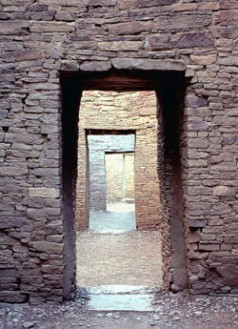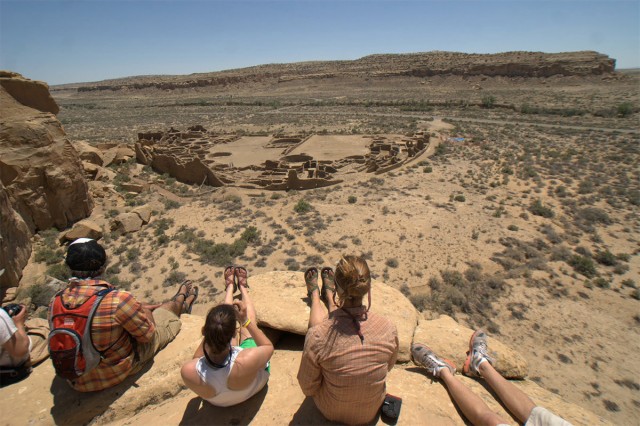Banner image by Ely Rareshide
The Dynamics of Chacoan Social and Spatial Networks, A.D. 800–1200
With National Science Foundation support (BCS-1355381), we collaborated with a team of researchers (including Archaeology Southwest’s Paul Reed and ASU’s Matt Peeples) to look at the dynamics of social and spatial networks in the archaeology of the Chaco region of the U.S. Southwest. Our investigation built on considerable research in the Chaco region by compiling a new dataset that will integrate architectural and artifact data from within and outside Chaco Canyon. The database serves as a basis for computerized social network and geographic information systems (GIS) analyses.
Chaco Canyon—a UNESCO World Heritage Site—is at the spatial center of the “Chaco World.” The canyon contains a concentration of architectural features known as great houses and great kivas, all dating between the tenth and early twelfth centuries. How this region came to prominence and the nature of the relationship of the central canyon to contemporaneous communities are enduring archaeological questions.
Our database adds to the Chaco World database at the Chaco Research Archive and to ceramic (pottery) and lithic (stone tools and related manufacturing debris) data for the period after A.D. 1200 from the Southwest Social Networks Project. New analyses of existing ceramic collections and obsidian provenance analyses augmented data from published and unpublished reports.
Using these data, we addressed the following questions:
- How were Chaco great houses related to one another?
- Were Pueblo Bonito and other Chaco Canyon great houses socially central in the regional network?
- How did trajectories of great house and great kiva social networks change over time? How did great houses and great kivas relate to their surrounding communities of small houses?
Recent research has suggested the need to analyze data from throughout the region, without assuming it was an integrated system, to better understand the ways in which great house communities were connected to one another and to the central canyon. Our investigation examined several questions currently being raised in many archaeological regions, not just Chaco. These include the relationship of hierarchy and centrality, and the role of specific historical processes—such as migration, social diversification, and inequality—in non-state societies.
Our work was designed to have broader impacts. We:
- Collaborated with the Chaco Research Archive to provide updates to the Chaco World Database
- Created a new database that integrates artifact data on great houses, great kivas, and selected outlier communities
- Shared what we are learning at public talks throughout the region
- Coedited a special issue of Archaeology Southwest Magazine, which is widely used for public outreach and in classrooms
- Authored a series of journal articles reporting our findings to our professional colleagues
- Trained graduate students in the application of social network analysis to archaeological datasets
— Written by Barbara J. Mills (University of Arizona) and Jeffery J. Clark (Archaeology Southwest), Principal Investigators
Details
Related to This
-
Location Chaco Culture National Histori...
-
Project cyberSW

